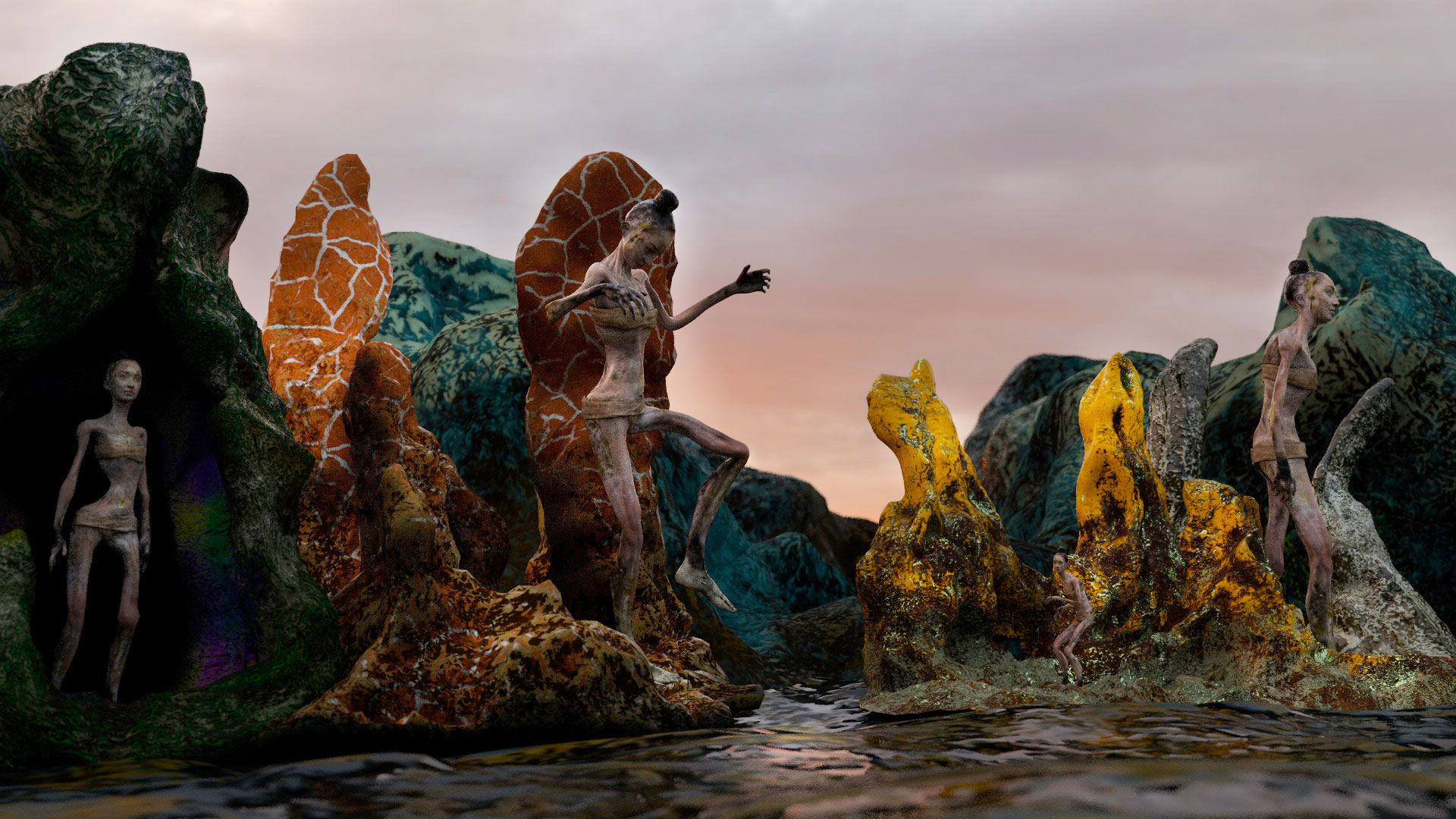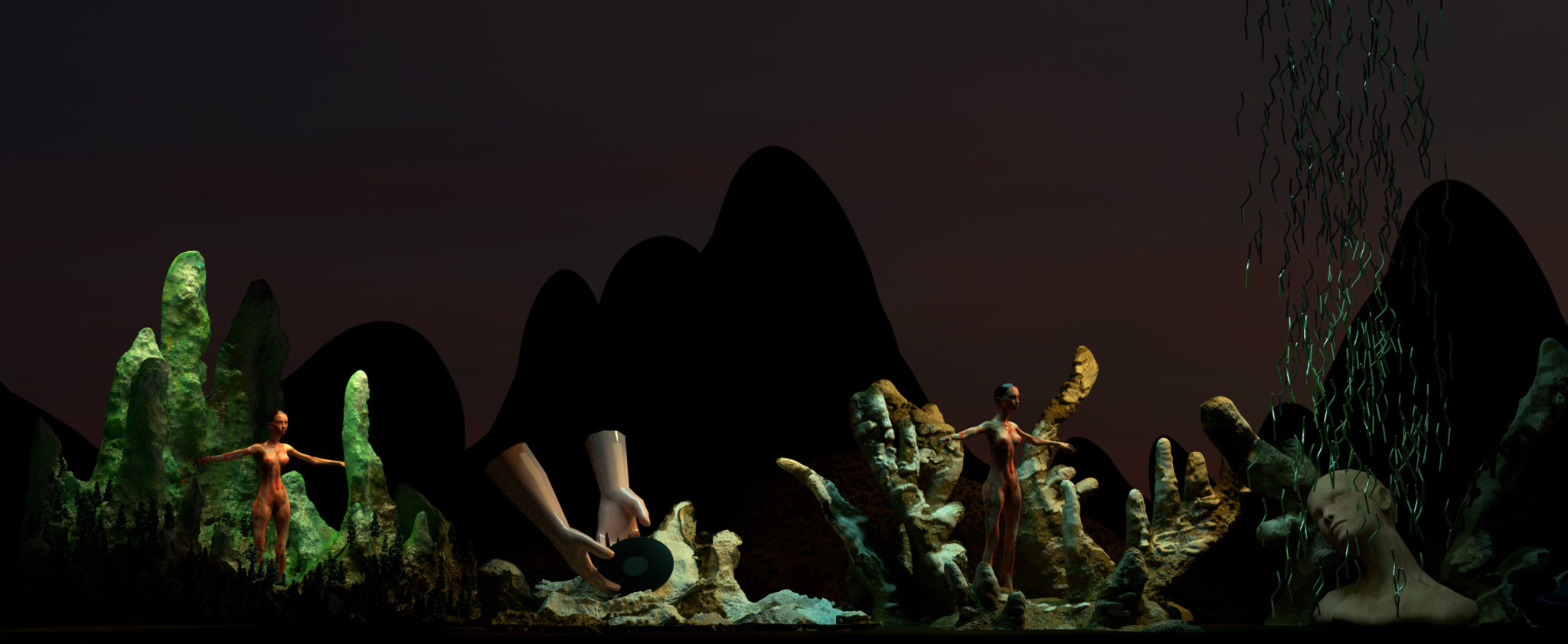The Team Discusses Its Collaborative Approach Behind the Scenes with Cinema 4D, ZBrush and More
The directing trio New Media Ltd. describe themselves as specializing in comedy, tragedy, live action, animation and VR. But those who’ve seen their work, including the new video short “The Giant,” would be right to say that they also excel at surrealism, storytelling and keeping people guessing.

Mike Anderson first conceived of “The Giant” as a live-action film but changed his mind as he worked on it over the years.
Recently called out as a Vimeo Staff Pick, “The Giant” premiered at SXSW and is the first 360 video made by the New Media Ltd. team of Mike Anderson, Abby Horton and Ryan Dickie. Relying primarily on Maxon Cinema 4D and Pixologic ZBrush, the three of them collaborated as they always do on projects — each taking on the creative role that makes sense for whatever they’re tackling. In this case, Horton handled production while Dickie focused on cameras and lighting. Anderson headed up just about everything else, and all of them weighed in on things like pace, look and feel as they worked.
Here, the three of them explain who they are, how they became New Media Ltd., and what their process was for making The Giant. One thing they won’t be clearing up, though, is what the video is all about. That, says Anderson, who wrote the original story years ago, is open to interpretation. “It’s definitely a piece of art that has an open-ended and very interpretive aspect to it,” he explaining that he was inspired by The Golden Compass author Philip Pullman’s 2012 retelling of Grimm’s Fairy Tales, Grimm Tales for Young and Old (published in the U.S. as Fairy Tales from the Brothers Grimm: A New English Version).

“The Giant” started with a storyboard designed for VR. It began with a 3D map and graphing out the camera path. The landscape was intentionally built to look like a record album.
“I was thinking about how people have things inside of them that they wish wouldn’t come out, and this young woman, by a series of unfortunate events, is made bigger and bigger until she becomes a giant,” he says. Strange and sometimes horrible things happen to the woman from that point on, and the story ends with what could be perceived as a moment of transcendence. “The things we do tend to have multiple interpretations, and our stuff is often very dark, strange and comedic, so depending on who watches it, they’re like: ‘Wow, that’s hilarious.’ Or, ‘Ugh, that’s fucked up.’ So we just sit back and let people say what they want while we make something else.”
StudioDaily: How did the three of you meet and form New Media Ltd?
Ryan Dickie: I went to school for cinematography, directing and editing, and Mike and I met in 2009 through friends and started collaborating on music videos and commercial projects. In 2012 we worked on a feature film called Blue Ruin, and that’s when we met Abby. A few years later, Mike asked us if we’d like to work with him on a music video called “Night Stalker.” so we all collaborated on that and we’ve been working together ever since. [Ryan and Abby started dating not long after meeting and recently got married.]
Mike Anderson: “Night Stalker” got into SXSW and was a really great thing for us. That band, Fort Lean, was great to work with and let us do whatever we wanted. I was a painter, and I got into directing through the props design world.
Abby Horton: We all come from solo directing careers and freelance careers in film. I have always been directing and I also produce and edit. When we started working together it was amazing because I felt like I learned three times as much as I normally would, and it pushed us to go with our craziest ideas and just see what happened.
MA: Yeasayer saw “Night Stalker” and called up to say that our stuff was great — and could we do a video for them? So we did “I Am Chemistry” and then “Silly Me”. We won a bunch of awards for “I Am Chemistry” and it was dumbly obvious that we needed to form a company and do this, so we did that in about 30 minutes in a coffee shop one day.
This is your first 360-video project. How did your process work?
MA: It was a long process to make this. I first thought of it as being live action, but that didn’t work and then I tried straight animation and that didn’t feel right. Doing 360 video made it possible to create an entire world. We had to learn everything from the ground up, and it was just the three of us. Workflow was crazy at first because it was before R19 came out, so Cinema 4D didn’t yet have a native spherical camera.
We used Arnold for rendering, and Adobe’s Premiere had just added in the ability to preview VR, which helped a ton. At that time, we didn’t even have a VR headset, so to preview something, we had to render a super low-res image sequence out of C4D, bring it into Premiere to check it out, upload to YouTube and then use a couple of Google Cardboard [headsets] we got at an event to see how it looked. This kind of workflow gave us a lot of time to drink coffee while looking at little progress bars fill up.

Roughed-in temporary lighting was used in this landscape test. “VR makes you build the entire story at once, which is a good thing, but it can make your head spin,” says Mike Anderson.
AH: It’s good to have us all working together because there are so many ways you can come at CGI, but you have to remember: ‘What is my story? What is it that I want to get across? It’s easy to forget that when you’re thinking about things like cinematography and the physicality of the camera. But you have to consider story and emotion together with cinematography and physicality, because those style elements are all in service to the story.
M.A.: Abby’s right, and I’m glad that she’s here because Ryan and I nerd out sometimes and she’s the one who says, ‘Hey, how is this serving the story?’
How did you create the Giant character?
M.A.: We did a 3D scan of model Abigail Vansteenberghe to use as the basis for the character. The scan had a couple of unforeseen errors, so I ended up sculpting about 90 percent of the character and painted the texture with projection. Photogrammetry is great because you can get a great base mesh to use as a reference really fast. Everything was animated with motion capture. We’ve got a Perception Neuron suit and I hate acting, but I had to throw on the suit and play every part. It sucked, but we all bite the bullet for projects sometimes.

Hundreds of lighting tests were done before the team chose the look they wanted and thought they could achieve in the time they had.
How was this shown at SXSW, and how did that go?
R.D.: We had a booth, and we were using Samsung Gear VR, so we were like, ‘Here, unsuspecting victim. Put this on and then we can watch your face.’ It was very intimate to see people’s reactions one at a time rather than as a big group in a theater. We learned so much doing this project, and the VR community has been so generous and open about sharing processes. We want to pay it forward, so people should get in touch with us if they have any questions.
What are you working on now?
M.A.: We just finished a fashion video for the new Phelan collection. We’re also working on an episodic series that is a mix of live action and animation. It’ll be fun, and we’re pitching it soon in New York.
Sections: Creativity
Topics: Project/Case study Q&A 360 video arnold cinema 4d Maxon new media ltd perception neuron
Did you enjoy this article? Sign up to receive the StudioDaily Fix eletter containing the latest stories, including news, videos, interviews, reviews and more.




